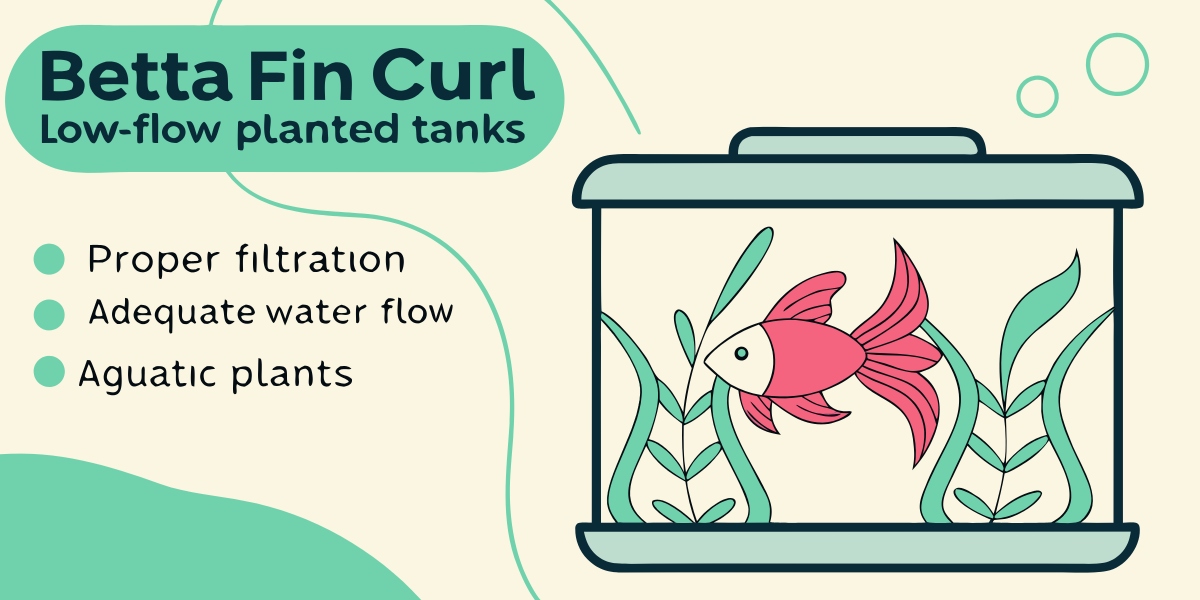Introduction
Betta fish are cherished for their vivid colors and flowing fins. However, in carefully curated low-flow planted tanks — which mimic their natural habitat — an unexpected challenge can arise: fin curl. This condition is a subtle yet serious indicator of underlying health or environmental issues. In this article, we’ll explore what causes fin curl in bettas housed in low-flow planted aquariums and how you can effectively prevent it while maintaining a thriving aquascape.
What is Betta Fin Curl?
Fin curl, also known as fin clamping or fin deformity, occurs when a betta’s tail or fins appear twisted, wavy, or rolled at the edges. It differs from fin rot, which is a bacterial infection that causes the fins to degrade. In fin curl:
- The fin edges may look crumpled or spiraled
- Fins may lose their symmetry but remain intact
- There are no signs of decay or discoloration initially
Common Causes of Fin Curl in Low-Flow Tanks
1. Poor Water Quality
Even in beautifully planted tanks, waste buildup and unstable parameters can affect bettas. In low-flow systems, filtration is gentler — but so is circulation, meaning ammonia or nitrite hotspots can form.
Ideal Water Parameters for Bettas:
- Temperature: 76–82°F (24–28°C)
- pH: 6.8–7.5
- Ammonia: 0 ppm
- Nitrite: 0 ppm
- Nitrate: <20 ppm
2. Improper Water Hardness (GH/KH Imbalance)
Soft water can weaken fin structure. Many planted tanks use RO or distilled water which lacks minerals. Bettas need calcium and magnesium for cellular health.
Solution: Use a remineralizer or add crushed coral to the substrate.
3. Low-Flow Circulation Issues
While bettas dislike strong currents, stagnant water may lead to bacterial or fungal growth, resulting in fin curl indirectly. Biofilm buildup is also common in still corners.
Solution: Adjust your sponge filter or gentle HOB filter for subtle surface movement.
4. Inadequate Tank Size
Small tanks (<3 gallons) are harder to stabilize in terms of parameters and temperature, increasing stress.
5. Stress and Poor Diet
Stress from poor tank mates, irregular lighting, or a lack of hiding spaces can suppress a betta’s immune system. Likewise, low-quality foods can lead to vitamin deficiencies.
How to Prevent Betta Fin Curl in Low-Flow Planted Aquariums
1. Maintain Pristine Water Quality
- Perform 20–30% water changes weekly
- Use a reliable test kit (API Master Kit recommended)
- Remove decaying leaves, uneaten food, and fish waste
Pro Tip: Use Indian almond leaves (catappa) for natural antibacterial benefits.
2. Optimize Filtration Without Causing Turbulence
Use filters like:
- Sponge filters with adjustable airflow
- Low-flow internal filters (ex: AquaClear on low setting)
- Lily pipe returns or spray bars to disperse water gently
Goal: Gentle water movement, not zero movement.
3. Stabilize Temperature & Prevent Fluctuations
- Use an adjustable heater with a built-in thermostat
- Avoid placing the tank near windows or vents
- Monitor with a digital thermometer
4. Balance GH/KH (General & Carbonate Hardness)
- Add Seachem Equilibrium or similar mineral supplements
- Maintain GH between 4–8 dGH, KH between 3–6 dKH
- Avoid pure RO water without remineralization
5. Feed a High-Quality Diet Rich in Protein & Nutrients
- Use betta-specific pellets (ex: Fluval Bug Bites, Northfin)
- Supplement with live or frozen foods: brine shrimp, daphnia, bloodworms
- Feed once or twice daily in small portions
Avoid overfeeding — bloating and constipation can indirectly weaken immune response.
6. Enrich the Environment & Reduce Stress
- Add real plants like Java Fern, Anubias, or Water Sprite
- Include hiding spots: driftwood, betta caves, leaf hammocks
- Use a gentle light cycle (8–10 hrs/day with timers)
7. Avoid Chemical Contaminants
- Rinse hands before tank maintenance
- Avoid air fresheners, perfumes, or sprays near the aquarium
- Use water conditioners that neutralize chloramines and heavy metals
Infographic: “Preventing Betta Fin Curl in Planted Tanks”
1. Water Quality (pH 6.8–7.5, Temp 78–80°F, 0 Ammonia/Nitrite)
2. Low-Flow Filter Setup (Sponge or spray bar)
3. Balanced GH/KH (Use remineralizer like Seachem Equilibrium)
4. Clean Diet (High protein pellets + live foods)
5. Enriched Tank (Plants + hiding caves)
6. Consistent Temperature (No sudden changes)
7. Weekly Water Changes (25–30%)
8. Avoid Toxins (No chemicals or sprays nearby)
FAQ: Betta Fin Curl in Low-Flow Planted Aquariums
Q1: Can betta fin curl go away on its own?
Answer: In mild cases caused by water imbalances or diet, fin curl can improve with corrected conditions. However, advanced curl from genetics or long-term stress may be permanent.
Q2: Is fin curl the same as fin rot?
Answer: No. Fin curl involves twisting or curling with intact tissue, while fin rot leads to fin degradation, fraying, or blackening and often requires medication.
Q3: Should I increase flow to stop fin curl?
Answer: Not necessarily. Moderate flow is fine, but bettas dislike strong currents. Optimize filtration for subtle circulation without stressing the fish.
Q4: Can hard water help prevent fin curl?
Answer: Yes, to an extent. Bettas benefit from water with moderate hardness (GH 6–8) as it provides essential minerals for fin and bone health.
Q5: What role do plants play in preventing fin curl?
Answer: Live plants improve water quality by reducing nitrates and giving bettas safe places to rest and hide — lowering stress, a key trigger of fin curl.
References
- Bailey, M. (2022). The Betta Bible. Aquarist Press.
- FishLab.com. (2024). “Betta Fish Water Parameters: Guide & Testing”
- Aquatic Veterinary Services. (2023). “Identifying and Treating Fin Curl in Ornamental Fish”
- Seachem Laboratories. (2023). “GH and KH Explained – Aquarium Chemistry”
- Aquarium Co-Op. (2024). “Best Filters for Betta Tanks & Planted Aquariums”
Conclusion
Preventing betta fin curl in a low-flow planted tank is all about balance: clean water, gentle circulation, proper mineral content, and stress-free environments. These beautiful fish thrive when their natural behaviors and biology are respected — even in compact aquascapes.
By implementing the tips above, you’ll not only prevent fin curl but also create a stunning, harmonious tank where your betta can flourish.

